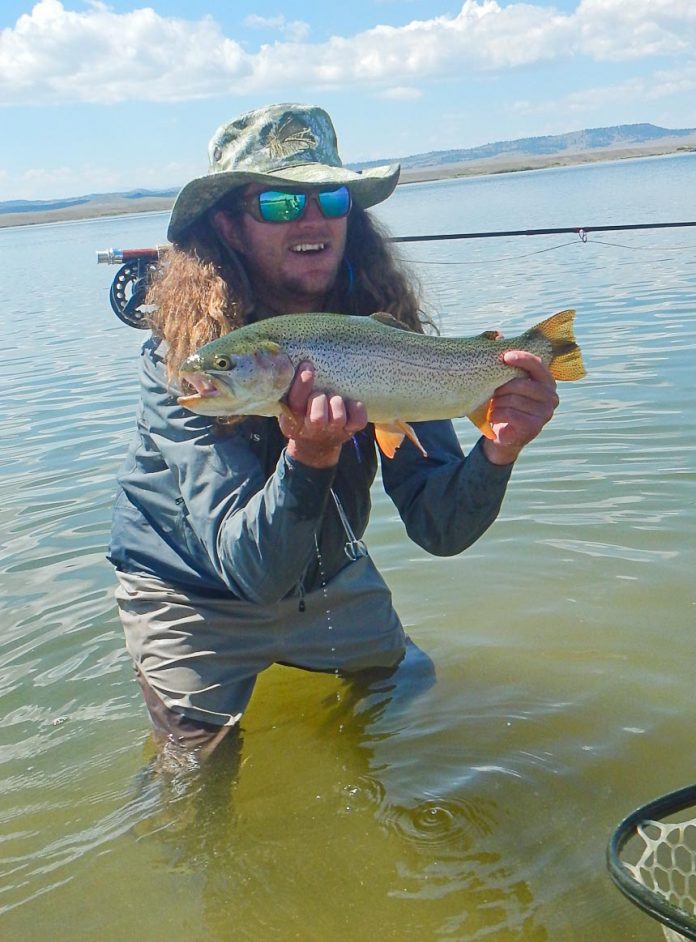Tips for the Non- Boat Crowd
Bob Volpe
One of the three shimmering blue jewels of the South Park area, just south of Fairplay, is Spinney Mountain Reservoir. Lately, wade fishing from shore with dries has been off the hook.
Having a boat, float tube, or pontoon is a great way to cover a lot of water when you are searching for fish, but wading the shoreline can be just as productive if you know what to look for.
We can’t all have boats. For the floating impaired, fishing from shore is a great way to spend the day alone, with buddies, or with the family. Basking in the sun, waist deep in the water, flipping big dry flies to rising rainbows is an exhilarating experience.
Spinney Mt. Reservoir is famous for producing some of the fattest, healthiest, trout in the state. It’s not unusual to get into trout in the five pound range here and in late summer they are willing and eager to slurp down big dries.
When you hook one of these beasties, you’re in for Colorado’s version of the Nantucket Sleigh Ride. These fish pull like freight trains and don’t ever give up. Watching your line peel off your screaming reel, and suddenly seeing your backing getting closer and closer to zipping through your rod guides is a rush. With patience and skill, you can manage to get these fish to the net. Just be ready for a lengthy fight.
Fly fishing guide and all around trout whisperer guru, Landon Meyer has some great tips on how to be a successful shoreline fly fisher. His techniques and experience have helped countless fishermen, women, and children become better anglers.
Here are some of Landon’s tips on fishing any lake from shore:
“The first plan of attack if you are not familiar with the terrain is to locate a topographic map for the fishery, or get somewhere-to-start advice from local experts. A map can show key drop-off points and shallow bays where trout cruise.
“Once you locate these drop-offs that follow the lake contours, try to find structural points that intersect these travel lanes. The tip of a point of land, or the mouth of a bay puts you closer to the fish as it forces them to funnel around you. In rocky terrain, these points can sometimes save the day during heavy wind. Use them to find shelter from the wind for easier casting and better sight-fishing. The last thing I look for is erratic structure that doesn’t show up on maps. Rocks, boulders, and weed beds supply habitat for insects, and cover for the trout that feed on them,
For those magical days when the wind dies down and the clouds cover the sun enough that the trout think it is a good time to rise, you’ll likely find them feeding on individual midge adults or midge clusters.
“Use a Grifftith’s Gnat or Parachute Adams (#16-20) and don’t focus on where a trout just rose. Concentrate on the trout’s head and what direction it is pointing or moving as it breaks the surface. Because these fish are on the move for food, they will not rise in the same spot twice. Lead the fish by three feet or more, allowing your fly to be in view as the trout approaches. Too many stillwater fly fishers spend their time casting just behind a trout because that’s where it just rose.
“For pinpoint presentations, cast beyond the feeding lane of the trout, and slowly pull the fly in front of the fish as it approaches. This small retrieve for accuracy will increase your success dramatically.”
As of late, dry flies of choice for Spinney have been Amy’s Ants, Callibaetis Spinners, and Beetles. Bring plenty of all of them, because you will break off some of these hefty brutes if you’re using 4X tippet (recommended).
Spinney Mt. Reservoir is designated as a Gold Medal fishery. These fishing areas have been designated by the Colorado Wildlife Commission as providing great spots to catch those large trout. These waters are defined as being able to produce 60 pounds of trout per acre, and at least twelve 14″ or larger trout per acre.
There is a $7 entrance fee, but all Colorado State Park passes are accepted.
Boats with or without motors are allowed, but are subjected to hull inspection for invasive species.
Rainbow Trout are not the only fish species swimming in Spinney. Browns, Cutbows, Cutthroat trout, and Pike also call the reservoir home.
Fishing regulations allow for one trout, over 20” to be taken. All other trout must be returned to the water immediately. Fishing is by flies and lures only. Anglers are encouraged to harvest all Pike.
Credit: Source link






























